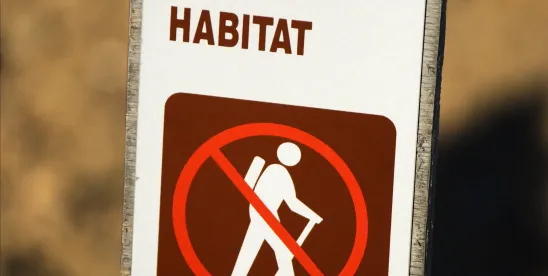On April 17, the U.S. Fish and Wildlife Service (“FWS”) and National Marine Fisheries Service (“NMFS”) (collectively, the “Services”) published a notice of proposed rulemaking that would rescind the Endangered Species Act (“ESA”) regulatory definition of “harm,” which currently incorporates habitat modification or degradation into the ESA statutory definition of “take.” 90 Fed. Reg. 16,102 (Apr. 17, 2025). Comments on the proposed rule are due by May 19, 2025.
This proposed rule reflects a significant reset of a core element of the ESA to narrow the application of the statute and is the first salvo in the Trump Administration’s anticipated efforts to revise the regulatory framework implementing the ESA. Following Executive Order 14154, “Unleashing American Energy” (Jan. 20, 2025), the Secretary of the Interior released a corresponding Secretarial Order 3418 directing, in part, actions to suspend, revise, or rescind the Biden Administration’s 2024 ESA rules that revised the regulations implementing Sections 4, 4(d), and 7. This next suite of proposed rules are anticipated to be published in October 2025.
Background
The ESA prohibits the “take” of endangered species, and the prohibition can be applied to threatened species. 16 U.S.C. §§ 1538(a)(1)(B)-(C) & 1533(d). The term “take” is statutorily defined as “to harass, harm, pursue, hunt, shoot, wound, kill, trap, capture, or collect, or to attempt to engage in any such conduct.” Id. § 1532(19) (emphasis added). A person can receive authorization to incidentally take an ESA-listed species through the Section 7 consultation process or a permit issued pursuant to Section 10.
By regulation, the Services have defined “harm” as “an act which actually kills or injures wildlife. Such act may include significant habitat modification or degradation where it actually kills or injures wildlife by significantly impairing essential behavioral patterns, including breeding, feeding or sheltering.” 50 C.F.R. § 17.3 (FWS’s definition); see also 50 C.F.R. § 22.102 (NMFS’s materially identical definition). In 1995, the U.S. Supreme Court, relying on Chevron, upheld the regulation in a 6-3 decision, holding that the Services reasonably construed the intent of Congress by including the “significant habitat modification or destruction” provision within the definition of “harm.” Babbitt v. Sweet Home Chapter of Communities for a Great Or., 515 U.S. 687, 708 (1995) (Justice Scalia authored the dissent).
Proposed Rescission
In the proposed rule, relying on Justice Scalia’s dissent in Sweet Home and the Supreme Court’s recent decision in Loper Bright Enterprises v. Raimondo (which overruled the Chevron doctrine), the Services state that the regulatory definition of “harm” is inconsistent with the historical understanding of “take.” As the Services explain, “take” has long meant “to reduce [wild] animals, by killing or capturing, to human control.” Accordingly, “harm,” when read in conjunction with the other verbs in the statutory definition of “take,” requires an “affirmative act[] . . . directed immediately and intentionally against a particular animal—not [an] act[] or omission[] that indirectly and accidentally cause[s] injury to a population of animals.”
Pursuant to Loper Bright, the Services concluded that the existing regulatory definition of “harm” does not match “the single, best meaning of the statute.” Instead of proposing a replacement, the Services intend to rely on the definition of “take” in the ESA statute because further elaborating on one subcomponent of that definition is unnecessary given the comprehensive statutory definition. The recission of the regulatory definition of “harm” would apply prospectively and would not affect already granted permits.
Implications
While prospective in application, if finalized, the recission of the definition of “harm” would have significant, nationwide implications. First, the scope of what constitutes “take” would be much narrower, given the removal of habitat modification and the apparent focus on acts directed immediately and intentionally against a particular animal. As a result, many future activities and projects would have reduced exposure to liability for a potentially prohibited take. Second, in the permitting context, the narrower scope of “take” would likely result in corresponding limitations on the scope of measures that could be required either to “minimize” the impact of incidental take in Section 7 consultations or to “minimize and mitigate” the impact of take authorized by a Section 10 incidental take permit. Third, in the absence of a regulatory definition or any further guidance, some uncertainty regarding the scope and interpretation of “take” would remain, which could result in increased litigation challenging certain applications of the statutory definition. Finally, as has become the norm with respect to ESA regulations, subsequent administrations could reinstate the regulatory definition of “harm” or develop a new definition or interpretation of that term perpetuating regulatory instability.






 />i
/>i
